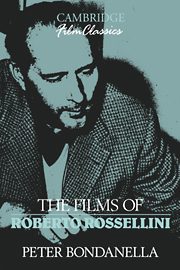Book contents
- Frontmatter
- Contents
- List of Illustrations
- Preface
- 1 Rossellini and Realism: The Trajectory of a Career
- 2 L'uomo dalla croce: Rossellini and Fascist Cinema
- 3 Roma città aperta and the Birth of Italian Neorealism
- 4 Paisà and the Rejection of Traditional Narrative Cinema
- 5 La macchina ammazzacattivi: Doubts about the Movie Camera as a Morally Redemptive Force
- 6 Viaggio in Italia: Ingrid Bergman and a New Cinema of Psychological Introspection
- 7 Il generale Della Rovere: Commercial Success and a Reconsideration of Neorealism
- 8 La prise de pouvoir par Louis XIV: Toward a Didactic Cinema for Television
- Notes
- Chronology
- Filmography
- Bibliography
- Index
3 - Roma città aperta and the Birth of Italian Neorealism
Published online by Cambridge University Press: 12 January 2010
- Frontmatter
- Contents
- List of Illustrations
- Preface
- 1 Rossellini and Realism: The Trajectory of a Career
- 2 L'uomo dalla croce: Rossellini and Fascist Cinema
- 3 Roma città aperta and the Birth of Italian Neorealism
- 4 Paisà and the Rejection of Traditional Narrative Cinema
- 5 La macchina ammazzacattivi: Doubts about the Movie Camera as a Morally Redemptive Force
- 6 Viaggio in Italia: Ingrid Bergman and a New Cinema of Psychological Introspection
- 7 Il generale Della Rovere: Commercial Success and a Reconsideration of Neorealism
- 8 La prise de pouvoir par Louis XIV: Toward a Didactic Cinema for Television
- Notes
- Chronology
- Filmography
- Bibliography
- Index
Summary
In spite of the many precursors film historians have cited as antecedents of Italian neorealism during the fascist period, and especially during the early 1940s, the birth of Italian neorealism is historically and emotionally linked forever with the astounding international success of Rossellini's portrayal of life in Nazi-occupied Rome between the fall of the fascist regime in September 1943 and its liberation in June of the following year. Unlike the fate of almost all other neorealist films, which seldom had a respectable showing at the box office and were rarely smash hits, Roma città aperta was the largest grossing film in Italy during the year it first appeared, and critical reactions in France and the United States, as well as box-office successes there, were equally positive. In addition, the fact that Paisà was screened abroad almost simultaneously with Roma città aperta helped to create a consciousness among film critics that something new was brewing in Italy (neorealism) and that this new aesthetic phenomenon was largely the creation of an obscure Italian director named Roberto Rossellini.
The film's plot, put together by a team of scriptwriters that included Rossellini, Federico Fellini, and Sergio Amidei, is deceptively simple. A Marxist partisan leader named Giorgio Manfredi who is being hidden from the Germans by a printer named Francesco enlists the assistance of a partisan priest, Don Pietro. The next day, just before Francesco is to be married to his pregnant fiancée, Pina, she is gunned down by the Germans when they arrest Francesco.
- Type
- Chapter
- Information
- The Films of Roberto Rossellini , pp. 45 - 63Publisher: Cambridge University PressPrint publication year: 1993



